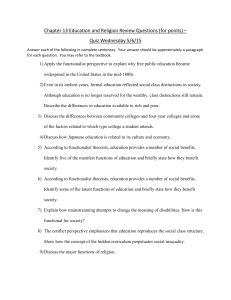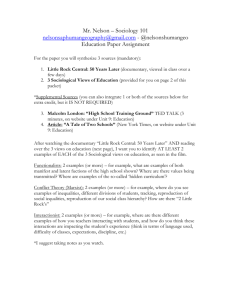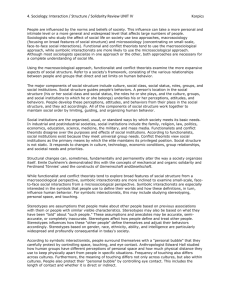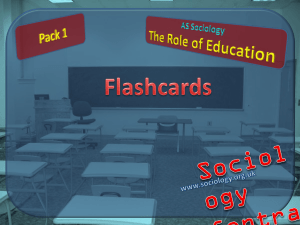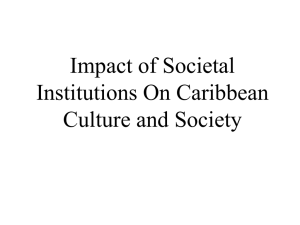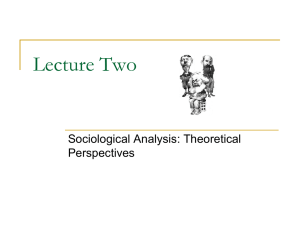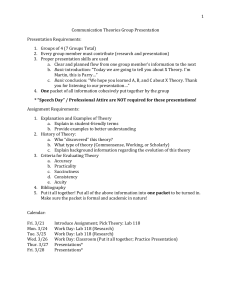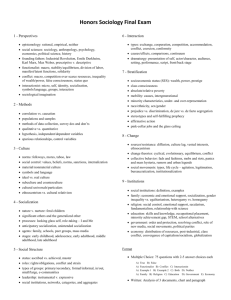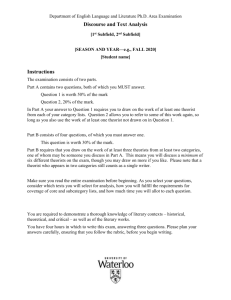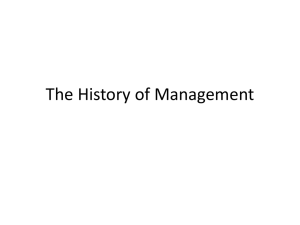moral education
advertisement
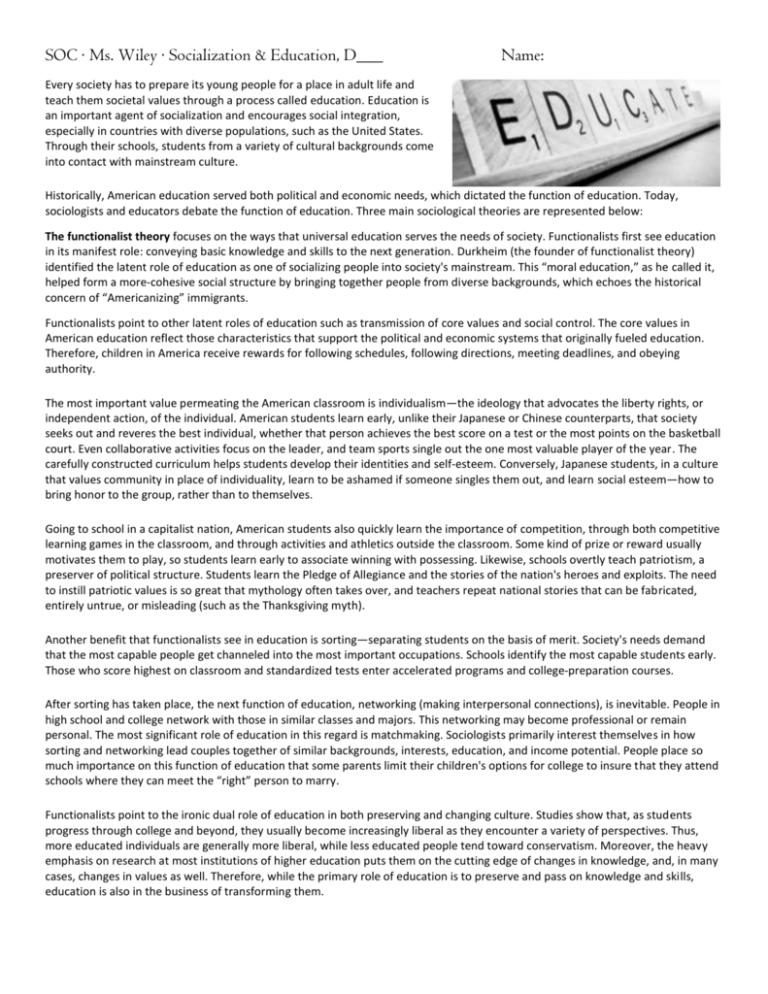
SOC ∙ Ms. Wiley ∙ Socialization & Education, D___ Name: Every society has to prepare its young people for a place in adult life and teach them societal values through a process called education. Education is an important agent of socialization and encourages social integration, especially in countries with diverse populations, such as the United States. Through their schools, students from a variety of cultural backgrounds come into contact with mainstream culture. Historically, American education served both political and economic needs, which dictated the function of education. Today, sociologists and educators debate the function of education. Three main sociological theories are represented below: The functionalist theory focuses on the ways that universal education serves the needs of society. Functionalists first see education in its manifest role: conveying basic knowledge and skills to the next generation. Durkheim (the founder of functionalist theory) identified the latent role of education as one of socializing people into society's mainstream. This “moral education,” as he called it, helped form a more‐cohesive social structure by bringing together people from diverse backgrounds, which echoes the historical concern of “Americanizing” immigrants. Functionalists point to other latent roles of education such as transmission of core values and social control. The core values in American education reflect those characteristics that support the political and economic systems that originally fueled education. Therefore, children in America receive rewards for following schedules, following directions, meeting deadlines, and obeying authority. The most important value permeating the American classroom is individualism—the ideology that advocates the liberty rights, or independent action, of the individual. American students learn early, unlike their Japanese or Chinese counterparts, that society seeks out and reveres the best individual, whether that person achieves the best score on a test or the most points on the basketball court. Even collaborative activities focus on the leader, and team sports single out the one most valuable player of the year. The carefully constructed curriculum helps students develop their identities and self‐esteem. Conversely, Japanese students, in a culture that values community in place of individuality, learn to be ashamed if someone singles them out, and learn social esteem—how to bring honor to the group, rather than to themselves. Going to school in a capitalist nation, American students also quickly learn the importance of competition, through both competitive learning games in the classroom, and through activities and athletics outside the classroom. Some kind of prize or reward usually motivates them to play, so students learn early to associate winning with possessing. Likewise, schools overtly teach patriotism, a preserver of political structure. Students learn the Pledge of Allegiance and the stories of the nation's heroes and exploits. The need to instill patriotic values is so great that mythology often takes over, and teachers repeat national stories that can be fabricated, entirely untrue, or misleading (such as the Thanksgiving myth). Another benefit that functionalists see in education is sorting—separating students on the basis of merit. Society's needs demand that the most capable people get channeled into the most important occupations. Schools identify the most capable students early. Those who score highest on classroom and standardized tests enter accelerated programs and college‐preparation courses. After sorting has taken place, the next function of education, networking (making interpersonal connections), is inevitable. People in high school and college network with those in similar classes and majors. This networking may become professional or remain personal. The most significant role of education in this regard is matchmaking. Sociologists primarily interest themselves in how sorting and networking lead couples together of similar backgrounds, interests, education, and income potential. People place so much importance on this function of education that some parents limit their children's options for college to insure that they attend schools where they can meet the “right” person to marry. Functionalists point to the ironic dual role of education in both preserving and changing culture. Studies show that, as students progress through college and beyond, they usually become increasingly liberal as they encounter a variety of perspectives. Thus, more educated individuals are generally more liberal, while less educated people tend toward conservatism. Moreover, the heavy emphasis on research at most institutions of higher education puts them on the cutting edge of changes in knowledge, and, in many cases, changes in values as well. Therefore, while the primary role of education is to preserve and pass on knowledge and skills, education is also in the business of transforming them. A final and controversial function assumed by education in the latter half of the twentieth century is replacement of the family. Many issues of career development, discipline, and human sexuality—once the domain of the family—now play a routine part in school curriculum. Parents who reject this function of education often choose to home‐school their children or place them in private schools that support their values. 1. From the functionalist perspective, what are some of the manifest functions of education? 2. From the functionalist perspective, what are some of the latent functions of education? 3. Which of the functions of education explored above might be troublesome, problematic, or controversial? Why? How do you feel about the issue? Conflict theory sees the purpose of education as maintaining social inequality and preserving the power of those who dominate society. Conflict theorists examine the same functions of education as functionalists. Functionalists see education as a beneficial contribution to an ordered society; however, conflict theorists see the educational system as perpetuating the status quo by dulling the lower classes into being obedient workers. Both functionalists and conflict theorists agree that the educational system practices sorting, but they disagree about how it enacts that sorting. Functionalists claim that schools sort based upon merit; conflict theorists argue that schools sort along distinct class and ethnic lines. According to conflict theorists, schools train those in the working classes to accept their position as a lower‐class member of society. Conflict theorists call this role of education the “hidden curriculum.” Conflict theorists point to several key factors in defending their position. First, property taxes fund most schools; therefore, schools in affluent districts have more money. Such areas are predominantly white. They can afford to pay higher salaries, attract better teachers, and purchase newer texts and more technology. Students who attend these schools gain substantial advantages in getting into the best colleges and being tracked into higher‐paying professions. Students in less affluent neighborhoods that do not enjoy these advantages are less likely to go to college and are more likely to be tracked into vocational or technical training. They also represent far higher numbers of minority students. Conflict theorists contend that not only do the economics favor the white affluent, but so does school testing—particularly IQ testing, which schools can use to sort students. They argue that the tests, which claim to test intelligence, actually test cultural knowledge and therefore exhibit a cultural bias. For example, a question may ask: “Which one of these items belongs in an orchestra? A. accordion B. guitar C. violin D. banjo.” This question assumes considerable cultural knowledge, including what an orchestra is, how it differs from a band, and what instruments comprise an orchestra. The question itself assumes exposure to a particular kind of music favored by white upper classes. Testing experts claim they have rid modern exams of such culturally biased questioning, but conflict theorists respond that cultural neutrality is impossible. All tests contain a knowledge base, and that knowledge base is always culturally sensitive. Conflict theorists see education not as a social benefit or opportunity, but as a powerful means of maintaining power structures and creating a docile work force for capitalism. 4. According to conflict theory, what are the roles of education in America? 5. How do conflict theorists differ from functionalist? 6. What solutions can you generate that would offset one of the problems investigated by conflict theorists? Symbolic interactionists limit their analysis of education to what they directly observe happening in the classroom. They focus on how teacher expectations influence student performance, perceptions, and attitudes. Robert Rosenthal and Lenore Jacobson conducted the landmark study for this approach in 1968. First, they examined a group of students with standard IQ tests. The researchers then identified a number of students who they said would likely show a sharp increase in abilities over the coming year. They informed the teachers of the results, and asked them to watch and see if this increase did occur. When the researchers repeated the IQ tests at the end of the year, the students identified by the researchers did indeed show higher IQ scores. The significance of this study lies in the fact that the researchers had randomly selected a number of average students. The researchers found that when the teachers expected a particular performance or growth, it occurred. This phenomenon, where a false assumption actually occurs because someone predicted it, is called a self‐fulfilling prophesy. For example, the stock market may be stable with rising values. If investors become afraid that the market will crash, however, they may suddenly sell their stocks, which causes the market to crash. The crash occurred simply because investors feared it would do so. Ray Rist conducted research similar to the Rosenthal‐Jacobson study in 1970. In a kindergarten classroom where both students and teacher were African American, the teacher assigned students to tables based on ability; the “better” students sat at a table closer to her, the “average” students sat at the next table, and the “weakest” students sat at the farthest table. Rist discovered that the teacher assigned the students to a table based on the teacher's perception of the students' skill levels on the eighth day of class, without any form of testing to verify the placement. Rist also found that the students the teacher perceived as “better” learners came from higher social classes, while the “weak” students were from lower social classes. Monitoring the students through the year, Rist found that the students closer to the teacher received the most attention and performed better. The farther from the teacher a student sat, the weaker that student performed. Rist continued the study through the next several years and found that the labels assigned to the students on the eighth day of kindergarten followed them throughout their schooling. While symbolic‐interactionist sociologists can document this process, they have yet to define the exact process of how teachers form their expectations or how students may communicate subtle messages to teachers about intelligence, skill, and so forth. 7. What are some of the elements of education that symbolic interactionists study? 8. What solutions can you generate that would offset one of the problems investigated by symbolic interactionists? 9. Which perspective, functionalist, conflict, or symbolic interactionist, do you find most interesting? Why? Savage Inequalities, by Johnathan Kozol, 1991 [Record this document # at the top of the Kozol excerpt.] For two years, beginning in 1988, Jonathan Kozol visited schools in neighborhoods across the country, from Illinois to Washington, D.C., and from New York to San Antonio. He spoke with teachers, principals, superintendents, and, most important, children. What he found was devastating. Not only were schools for rich and poor blatantly unequal, the gulf between the two extremes was widening—and it has widened since. The urban schools he visited were overcrowded and understaffed, and lacked the basic elements of learning—including books and, all too often, classrooms for the students. In Savage Inequalities, Kozol delivers a searing examination of the extremes of wealth and poverty and calls into question the reality of equal opportunity in our nation’s schools. Read the excerpt and respond to the questions that follow: 10. Summarize the excerpt provided. What are the key facts/findings/arguments? 11. What is your reaction the excerpt? Socialization Messages in Primary Schools, from Sociology of Education, January 2002 [Record this document # at the top of the Socialization Messages excerpt.] 12. What are the top two teacher-initiated socialization messages identified in the study? What evidence supports this? 13. Do you think the skills mentioned in the excerpt are critical in socializing students? Suggest how the skills will or will not benefit students outside of the classroom.
